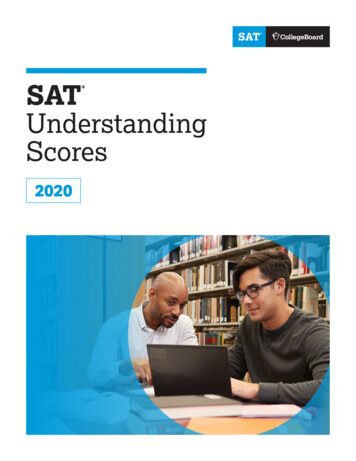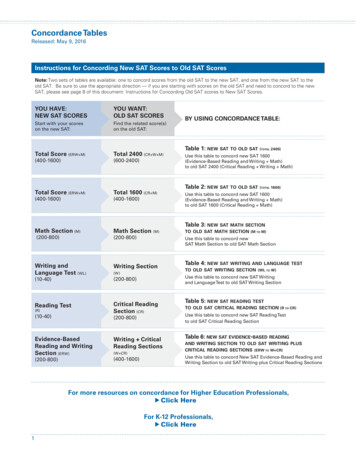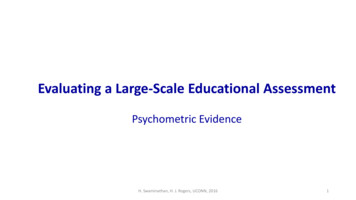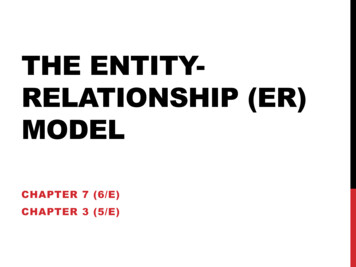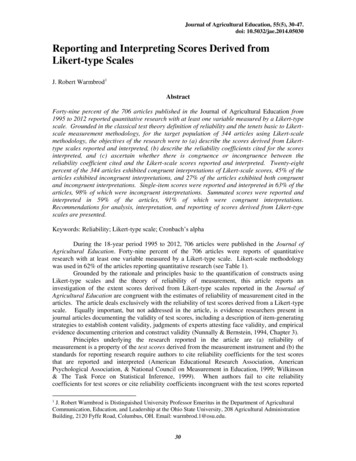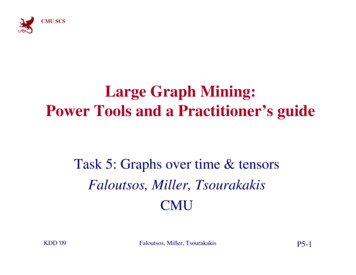
Transcription
THE RELATIONSHIP BETWEEN TEACHERINSIGHT SCORES ANDPROFESSIONAL DEVELOPMENT AND APPRAISALSYSTEM DOMAIN SCORESMichael T. Novotny, B.A., M.Ed.Dissertation Prepared for the Degree ofDOCTOR OF EDUCATIONUNIVERSITY OF NORTH TEXASMay 2009APPROVED:Jane B. Huffman, Major ProfessorRobin Henson, Minor ProfessorBill Camp, Committee MemberCarol Wickstrom, Interim Chair of theDepartment of Teacher Educationand AdministrationJerry Thomas, Dean of the College ofEducationMichael Monticino, Interim Dean of theRobert B. Toulouse School ofGraduate Studies
Novotny, Michael T. The Relationship Between TeacherInsight Scores andProfessional Development and Appraisal System Domain Scores. Doctor of Education(Educational Administration), May 2009, 100 pp., 5 tables, references, 123 titles.Many school districts and alternative certification programs use standardizedinterviews such as the TeacherInsight developed by the Gallup Organization. TheTeacherInsight is a Web-based interview consisting of multiple choice and Likert-styleitems that produces a score between 0 and 100. The Gallup Organization claims that ithelps hire the best teachers.The study analyzed the relationships between the TeacherInsight scores and theeight Professional Development Appraisal System (PDAS) domain scores for 527teachers.The TeacherInsight scores produced a statistically significant correlation withonly one of the eight PDAS domain scores. However, even that correlation (r 0.14)was weak. All eight PDAS domain scores were only able to account for an additional1.9% of the variance of TeacherInsight scores, above and beyond what was explainedby the teachers’ age, gender, years of experience, and highest degree earned. Anotherfinding was that 47.4% of the teachers hired had TeacherInsight scores below thedistrict recommended cutoff score of 67.The findings do not support the ability of the TeacherInsight to identify moreeffective teachers, based on Professional Development Appraisal System scores. Thefindings also cast doubt on the extent of consideration that principals in this district givethe TeacherInsight scores during the selection process. Recommendations for futurestudies are provided.
Copyright 2009ByMichael T. Novotnyii
ACKNOWLEDGMENTSFirst and foremost, I thank God. Everything I accomplish, including completingthis dissertation, is only possible through Him.I am very thankful for the support of my family. My three boys, Andrew, Ryan,and Thomas, and my beautiful wife, Laura, have demonstrated incredible patience,support, and love. I dedicate the completion of this project and degree to you. I alsoappreciate my parents for teaching me the value of education and for never giving up onme.I would like to thank Dr. Jane Huffman, my major professor, for your patience,support, and timely feedback. Thanks to Dr. Robin Henson, my minor professor, foryour expertise in research and statistics. Thanks also to Dr. Bill Camp for his feedbackand for challenging me to develop a quality dissertation study. In addition to your helpduring the dissertation process, I also appreciate the three of you for everything Ilearned from you during my doctorate coursework.I am grateful for the support of several employees of my former colleaguesincluding Dr. Doug Otto, superintendent, Jeff Bailey, deputy superintendent, TamiraGriffin, executive director of human resources, Becky Wussow, director of humanresources, James Ashby, director of assessment and accountability, and Jun Melvin,director of compensation and diversity. You are all outstanding educators, and it was aprivilege and honor to work with you.iii
TABLE OF CONTENTSPageACKNOWLEDGMENTS.iiiLIST OF TABLES .viiChapter1. INTRODUCTION .1Background .1Statement of the Problem.7Purpose .8Research Questions.8Methodology.9Limitations .9Definition of Terms .9Significance of the Study.13Organization of the Study.142. REVIEW OF THE LITERATURE .16Introduction.16Student Achievement and Accountability .18Texas Accountability Rating System .20Federal Adequate Yearly Progress.27Teacher Effectiveness and Student Achievement .32Teacher Evaluation .34Professional Development and Appraisal System (PDAS).36Teacher Selection .41Standardized Interviews .44Interactive Computer Information System-Urban (ICIS-Urban)44Principal Perceiver Interview (PPI) .45STAR Teacher Selection Interview .45iv
Teacher Perceiver Instrument (TPI) .47Urban Teacher Perceiver Interview (UTPI) .49TeacherInsight.50Summary .523. METHODS AND PROCEDURES .53Purpose .53Research Questions.54Context .54Study Participants .55Research Design.55Instrumentation .56Data Collection.58Data Analysis .58Summary.594. PRESENTATION AND ANALYSIS OF THE DATA .60Introduction .60Descriptive Data.60Description of the Population .60TeacherInsight .61Professional Development and Appraisal System.62Data Analysis .63Summary.725. SUMMARY, DISCUSSION, RECOMMENDATIONS, AND SUGESTIONSFOR FUTURE RESEARCH.74Introduction .74Background .74Overview of the Study .76Review of the Methodology .76Summary of the Findings .76Description of the Population .76v
TeacherInsight (TI) .78Professional Development and Appraisal System (PDAS).78Research Question 1.78Research Question 2.79Research Question 3.79Research Question 4.80Discussion of the Results .80Recommendations.84Suggestions for Further Studies .85Conclusions .87APPENDIX .89REFERENCES.91vi
LIST OF TABLESTablePage1. PDAS Domain Scores Descriptive Data.622. Correlation Matrix PDAS Domain Scores and TeacherInsight Scores .643. Correlation Matrix Teacher Characteristics and TeacherInsight Scores.654. Correlation Matrix PDAS Domain Scores and Teacher Characteristics .685. Hierarchical Multiple Regression of PDAS Domain Scores onTeacherInsight Score .71vii
CHAPTER 1INTRODUCTIONBackgroundStudent achievement is affected by many factors. Educators cannot control manyof these factors such as nutrition (Victora, Adair, Fall, Hallal, Martorell, Richter, &Sachdev, 2008), family’s socioeconomic level (Duncan & Magnuson, 2005), studentmobility (Alexander, Entwisle, & Dauber, 1996; Kerbow, 1996; Nelson, Simoni, &Adelman, 1996), mother’s educational expectations (Bennerm & Mistry, 2007),neighborhood influence (Sampson, Sharkey, & Raudenbush, 2007) and parentalinvolvement (Barron, 2007; Desimone, 1999). Barton and Coley (2007) found thatapproximately two-thirds of the large variance between states in eighth grade readingNational Assessment of Educational Progress (NAEP) can be accounted for by thefollowing four factors: single-parent families, parents reading to young children everyday, hours spent watching television, and the frequency of school absences. Otherfactors that affect achievement that schools do not have control over include parentparticipation, birth weight, lead poisoning, and parent availability (Barton, 2003).However, educators can influence many achievement factors including schoolsize (Howley & Bickel, 2000), teacher experience (Rockoff, 2004; Rivkin, Hanushek, &Kain, 2005; Kane, Rockoff, & Staiger, 2006), class size (Krueger, 1999) and curriculumand instructional strategies (Marzano, 2003). Other school-related factors that correlatewith student achievement include rigor of curriculum, teacher preparation, teacherexperience and attendance, class size, technology-assisted instruction, and schoolsafety (Barton, 2003).1
Researchers have determined that teacher effectiveness is one of the mostsignificant factors related to student achievement (Goldhaber, 2002; Rivkin, Hanushek,& Kain, 2005; Sanders & Rivers, 1996). It has also been found that disadvantagedstudents are much more likely to be taught by less qualified teachers (Langford, Loeb, &Wyckoff, 2002).Thus, teacher recruitment and selection is one of the most importantresponsibilities for school administrators. The process of teacher selection ofteninvolves several steps which include reviews of application, resume, portfolio, andtranscripts, and references checks. Interviews by human resources staff, principals andother campus staff are also critical to the hiring of qualified teachers. This process isoften very time-consuming for principals and human resource staff members. Thechallenge to hire quality teachers is amplified by the nation-wide shortage of teachersthat has been reported for many years (Hussar, 1999).In this study, the researcher investigated the predictive validity of theTeacherInsight (http://www.gallup.com). The TeacherInsight (TI) is a Web-basedinterview developed by the Gallup Organization that consists of multiple choice andLikert-scale questions. Based on the responses to the questions, applicants receive ascore between 0 and 100. The Gallup Organization claims that a higher TI score ispredictive of a more effective teacher (Gallup, 2008a).Selecting effective teachers has become even more important and challenging inrecent years. Federal and state laws are holding schools and districts more accountablefor student achievement. The Federal No Child Left Behind (NCLB) Act requiresstudents to be tested annually and for schools and districts to make Adequate Yearly2
Progress (AYP) through increases in the results of these tests (Public Law 107-110,2001). Many states also have their own accountability systems for student achievement.The Texas Education Agency rates schools and districts in one of four categories(Exemplary, Recognized, Academically Acceptable, and Academically Unacceptable)based on the Texas Assessment of Knowledge and Skills (TAKS) test scores and otherfactors such as attendance rate and completion rate. Students are required to pass theTAKS tests in 3rd, 5th, and 8th grades to be promoted to the next grade level. Studentsalso need to pass all four 11th grade exit level TAKS tests to graduate. Thus, effectiveteachers are critical to enable students to be successful and to ensure that schools anddistricts meet state and federal accountability requirements.There is often a shortage of teacher applicants in many districts and statesacross the country. More importantly, even when there is a sufficient supply of teacherapplicants, there may be a shortage of quality teacher applicants. College graduateswith higher ability, based on test scores and class rank, are less likely to go intoteaching (Guarino, Santibanez, Daley, & Brewer, 2004).The NCLB Act requires teachers of core subject areas to be highly qualified. Tomeet the definition of highly qualified, teachers need to have a bachelor’s degree, statecertification, and demonstrate proficiency in the subject area they teach. Todemonstrate proficiency, teachers need to pass a competency exam or demonstratetheir qualifications through a combination of college credits in the subject area, years ofteaching experience, and professional development. Whether highly qualified teachersare more effective than those that are not is debatable as a study by Dee and Cohodes(2008) found mixed results. Regardless, this requirement has further exacerbated the3
shortage of teacher candidates because many current teachers and new applicants arenot able to meet the highly qualified definition in a particular subject area.The teacher selection process varies considerably among districts and schools.Many districts use a centralized model in which teachers are hired by the personneldepartment and assigned to campuses. Other districts follow a more decentralizedprocess in which principals have more authority over which teachers are hired for theircampuses. Some districts follow a balanced approach that involves both the personneldepartment and the principals (Liu, 2002).The hiring process can be very subjective on the part of the administrator makingthe decision. One administrator may like a particular answer to an interview question,while another administrator may not. Also, different administrators look for differentqualities in teachers and use a variety of methods to evaluate those qualities. Inevitably,some administrators are more successful at selecting effective teachers than otheradministrators.The recruitment, selection, and training of new teachers requires a significantfinancial investment on the part of school districts. Barnes, Crowe, and Schaefer (2007)found that the average cost of replacing a teacher varied from 4,366 to 17,872,depending on the district. These include the payroll costs of the human resources andprofessional development staff, traveling to job fairs, mentoring programs, new teachertraining and workshops. This money is a great investment when successful teachers arehired who will stay in a district for years to come. However, the money is not well spentwhen ineffective teachers are selected or when teachers do not stay in the district long.There have been efforts to standardize the teacher selection process to make it4
more effective and objective and less time consuming. Standardized interview toolshave been used by many school districts for decades. Some examples include theHaberman Star Teacher Evaluation, Mesa Educator Perceiver Interview (MEPI),Emphasizing More Personalized Attitudes Toward Helping Youth (EMPATHY), Gallup’sTeacher Perceiver Interview (TPI), and Gallup’s Urban Teacher Perceiver Interview(Urban TPI).The Gallup Organization developed the TI tool to assist school districts inselecting teachers from their applicant pools. It is a web-based assessment instrumentconsisting of multiple choice and Likert items that requires approximately 30 minutes tocomplete. The TI tool produces a score from 0 to 100 based on an applicant’sresponses. The Gallup Organization says the TI provides the following benefits:TeacherInsight helps you hire the best teachers -- fast. Based on more than 30years of research into the talents of the very best teachers, TeacherInsightprovides a quick, effective way to source and assess a large volume ofapplicants. This innovative selection tool allows you to: Identify more teacher candidates like your best teachers Increase the speed of assessing applicants Reduce staff time spent interviewing applicants – and the associated costs Focus valuable district staff time on recruiting candidates Keep your HR office open 24/7Moving beyond knowledge and skills, TI assesses the talents that result inteacher excellence that are difficult or nearly impossible to teach. TheTeacherInsight assessment comes from qualitative and quantitative approaches5
with outstanding teachers and follow-up quantitative predictive validity studies.Consisting of multiple choice and Likert items in a Web-based assessment, TIcomplies with all Equal Employment Opportunity (EEO) guidelines.The TI assessment requires approximately 30 minutes to complete and isavailable 24/7. Results are based on the applicant's responses and include ascore that is predictive of an applicant's potential for teaching success based onhis or her talent. Once an applicant has completed TI, access to the results isnearly immediate. Gallup instantly reports scores to districts through its Webbased reporting site, Gallup Online. Districts can also automate applicantsaccessing TI and recording the results into existing applicant tracking systems.Gallup provides a seminar for principals, human resource specialists, and otherdistrict personnel in districts using TI. This seminar helps participants understandthe research behind the TI System and provides a foundation for interpreting theTI scores. The seminar also introduces participants to the Teacher FIT (FurtherInsight into Talent) interview, a supplemental set of questions that principals orother staff may use with applicants. (Gallup, 2008a, p.1)The Gallup Organization (2008b) claims that the TeacherInsight “ensures thedepth of teaching talent throughout the district” (p.1) Gallup also says that the TI“consistently measures the talent of every teacher you hire” (Gallup, 2008b, p.1).Many school districts across the country use the TI as part of their teacherapplication and selection process. Some school districts use a cut score and do notconsider applicants that fail to achieve or exceed that minimum score on the TI. Otherdistricts do not use a cut score and instead use the TI score as one source of6
information to be considered in the selection process. Regardless of which method adistrict utilizes, the TeacherInsight score inevitably affects applicants’ chances ofobtaining a position.Some alternative certification programs also use the TI as part of their selectionprocess. Thus, the TI not only can affect an individual’s chances of being hired by someschool districts, it can also determine whether someone is accepted into an alternativecertification program.Statement of the ProblemIt is critical that schools and districts identify highly effective, highly qualifiedteachers to raise student achievement. School districts have limited resources such astime, money, and manpower to achieve this task. If standardized interview tools such asthe TI are effective at identifying better teachers, the time and money spent on them areworthwhile. However, if these tools are not effective, then the time and money spentcould be better utilized elsewhere. Furthermore, if the TI does not effectively identifybetter teachers it could be preventing good candidates from being hired or from beingaccepted into alternative certification programs.Thus, the problem for educators is how to identify and hire effective teachers.Research conducted for this study examines the relationship between TI scores andteacher effectiveness. The results of this research provide school district administratorswith correlations between teachers’ TI interview tool scores and each of the eightdomain scores of their Professional Development and Appraisal System (PDAS)evaluations. Districts and schools may use this information to review their teacher7
selection methods. Improvements in the teacher selection process can increase theeffectiveness of the teachers hired, and as a result, increase student achievement.PurposeThe TI is being used by many school districts across the nation as part of theirhiring process. It is also used by many alternative certification programs as part of theiradmissions process.The Gallup Organization charges 17 per applicant for the administration of theTeacherInsight. However, the district being studied paid an annual fee of 42,000 for anunlimited number of administrations of the TI. If the TI is able to identify more effectiveteacher applicants, that time and money is well spent. However, if the TI does notreliably predict teacher effectiveness, then it is actually doing a disservice as it iswasting limited resources and, worse yet, potentially resulting in some less effectiveteachers being hired. Only one independent, published study could be found regardingthe TeacherInsight interview tool. One additional published study conducted by Gallupwas found. Additional research could benefit school administrators who are using, orconsidering the use of, the TI as part of the teacher selection process. Thus, thepurpose of this study is to determine the relationship between TI scores and teachereffectiveness, as measured by the Professional Development and Appraisal System.Research QuestionsThis study addressed the following research questions:1. What are the relationships between teachers’ TeacherInsight scores andeach of the eight domain scores of their PDAS evaluation ratings?8
2. What are the relationships between teachers’ TeacherInsight scores andtheir age, years of teaching experience, gender, and highest degreeearned?3. What are the relationships between teachers’ eight PDAS domain scoresand their age, years of teaching experience, gender, and highest degreeearned?4. To what extent do the eight PDAS domain scores predict the variability inthe TeacherInsight scores over and above that explained by teacher age,gender, years of experience, and highest degree earned?MethodologyThis study involved teachers hired into a North Texas school district for the 20062007 school year. Those teachers’ TI scores were collected, along with the eightdomain scores of their PDAS evaluation scores. The teachers’ demographic informationincluding age, years of teaching experience, gender, and highest degree earned werealso collected. The relationships between the teachers’ TI scores, eight domain PDASevaluation scores, age, years of teaching experience, gender, and highest degreeearned were studied through correlational and linear regression statistical methods.LimitationsThe data concerns only one North Texas school district. While the TI tool is usedby districts and schools across the country, specific interpretations of the results maynot be comparable to other states that do not use the PDAS teacher appraisal tool.Definition of TermsAcademic Excellence Indicator System (AEIS): pulls together a wide range of9
information on the performance of students in each school and district in Texas everyyear. This information is put into the annual AEIS reports, which are available each yearin the fall. The reports provide extensive information on school and district staff,finances, programs and student demographics. Performance on each of the followingindicators is shown disaggregated by ethnicity, sex, special education, low incomestatus, limited English proficient status, and at risk status (district only): Results of Texas Assessment of Knowledge and Skills (TAKS*); by grade, bysubject, and by all grades tested; Participation in the statewide assessment programs(TAKS/TAKS(Accommodated)/TAKS-M/TAKS-Alt); Exit-level TAKS Cumulative Passing Rates; Progress of Prior Year TAKS Failers; Results of Student Success Initiative; Attendance Rates; Annual Dropout Rates (grades 7-8, grades 7-12, and grades 9-12); Completion Rates (4-year longitudinal); College Readiness Indicators; Completion of Advanced / Dual Enrollment Courses; Completion of the Recommended High School Program or DistinguishedAchievement Program; Participation and Performance on Advanced Placement (AP) andInternational Baccalaureate (IB) Examinations; College-Ready Graduates; Texas Success Initiative (TSI) – Higher Education Readiness Component;and10
Participation and Performance on the College Admissions Tests (ScholasticAptitude Test [SAT] and American College Testing Assessment [ACT])(Texas Education Agency, 2008a, p.1).Accountability Ratings: are assigned to every school and district annually by TheTexas Education Agency (TEA). The different ratings include Exemplary, Recognized,Academically Acceptable, and Academically Unacceptable. These ratings aredetermined by three base indicators: TAKS and TAKS (Accommodated) scores,completion rate for grades 9 through 12, and annual dropout rate for grades 7 and 8.Adequate Yearly Progress (AYP): a federal accountability system mandatedunder the NCLB Act. There are many similarities and differences between the TexasAcademic Excellence Indicator System (AEIS) and federal AYP accountability systems.Economically Disadvantaged: one of the subgroups analyzed in the AEIS andAYP systems. Students that qualify for free or reduced lunch based on their familyhousehold income are included in this category.Gallup Organization: a company that has studied human nature and behavior formore than 70 years. This company developed the TeacherInsight tool and itspredecessor, the Teacher Perceiver.Highly Qualified (HQ): part of the NCLB Act of 2001. The law requires that allteachers of core academic subjects in the classroom be highly qualified. This isdetermined by three criteria: (1) attaining a bachelor's degree or better in the subjecttaught; (2) obtaining full state teacher certification; and (3) demonstrating knowledge inthe subjects taught.No Child Left Behind (NCLB) Act (Public Law 107-110, 2001): signed into law onJanuary 8, 2002. The legislation is based on four major areas or pillars: accountability11
for student achievement, focus on what works, flexibility, and parental involvement.There are five goals as part of this Act: By 2013-2014, all students will reach high standards, at a minimum attainingproficiency or better in reading/language arts and mathematics; All limited English proficient students will become proficient in English and reachhigh academic standards, at a minimum attaining proficiency or better inreading/language arts and mathematics; By 2005-2006, all students will be taught by highly qualified teachers; All students will be educated in learning environments that are safe, drug-free,and conducive to learning; All students will graduate from high school.The Act requires schools or districts that fail to make adequate yearly progress (AYP) toschool improvement interventions. The level of school improvement depends on howmany years the school or district has failed to make AYP.Professional Development and Appraisal System (PDAS): the State's approvedinstrument for appraising its teachers and identifying areas that would benefit from staffdevelopment. Cornerstones of the process include a minimum of one 45-minuteobservation and completion of the Teacher Self-Report form. PDAS includes 51 criteriawithin eight domains reflecting the Proficiencies for Learner-centered Instructionadopted in 1997 by the State Board for Educator Certification (SBEC) (Region XIIIEducation Service Center, 2008).TeacherInsight (TI): a web-based assessment developed by The GallupOrganization, consisting of multiple choice and Likert items that requires a
including Dr. Doug Otto, superintendent, Jeff Bailey, deputy superintendent, Tamira Griffin, executive director of human resources, Becky Wussow, director of human resources, James Ashby, director of assessment and accountability, and Jun Melvin, director of compensation and diversity. You are all outstanding educators, and it was a


